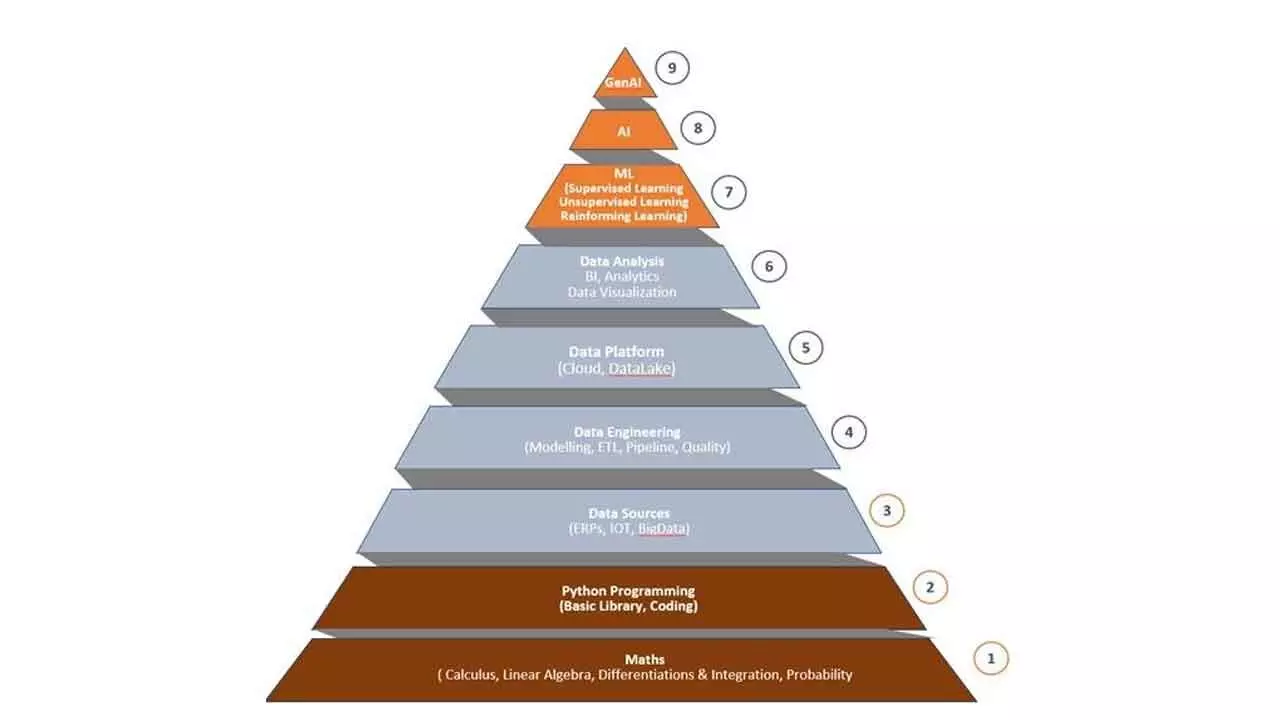Solidify Up Your GenAI Foundation To Ever Be On The Success Roadmap
AI models need a firm foundation in mathematics to function effectively
Solidify Up Your GenAI Foundation To Ever Be On The Success Roadmap

Python is the go-to language for AI development, thanks to its simplicity and rich libraries. Becoming proficient in Python is crucial for working with Gen AI. NumPy aids in numerical computations and linear algebra
Generative AI (GenAI) is rapidly transforming industries and reshaping how we work, communicate, and innovate. With its growing influence across sectors like healthcare, finance, and entertainment, acquiring GenAI expertise is crucial for anyone looking to remain relevant in the workforce.
We will provide a concise roadmap to build the essential skills and knowledge to succeed in the era of GenAI.
Mathematics is fundamental to AI. Just as a cricketer must understand the physics of the game, AI models need a solid foundation in mathematics to function effectively. Calculus helps optimize algorithms by studying how changes in parameters affect performance. Linear Algebra enables the analysis of complex data using vectors and matrices. Probability and statistics are essential for making predictions and evaluating model accuracy. Understanding these principles will help build the groundwork for creating effective AI models. Python is the go-to language for AI development, thanks to its simplicity and rich libraries. Becoming proficient in Python is crucial for working with GenAI. NumPy aids in numerical computations and linear algebra. Pandas’ is key for data manipulation and cleaning. Scikit-learn provide machine learning algorithms for predictive models.
TensorFlow/PyTorch are powerful tools for deep learning. Learning these libraries equips you with the tools needed to create and train AI systems.
Data sources:
The heart of AI, data fuels AI, and understanding how to work with different types of data is crucial. Structured data includes organized datasets like transaction records or customer data. Unstructured data refers to data like images, audio, and text, requiring specialized techniques. IoT Data comes from devices like sensors, providing real-time data. Big Data refers to large, complex datasets that require advanced tools for processing. Mastering these data types is essential to building AI systems that can learn and adapt.
Data engineering:
Data engineering focuses on preparing raw data for analysis. Its key processes include Data extraction: Gathering data from various sources; Data transformation: Cleaning and structuring the data for analysis; Data loading: Storing data in centralized platforms like data lakes or warehouses. Data engineers ensure that data is of high quality and in a usable format for AI modeling.
Data platforms:
Infrastructure, building a robust data platform is essential for managing vast amounts of data. Cloud platforms like AWS, Azure, and Google Cloud offer scalable solutions for data storage and processing. Data lakes allow companies to store raw, unstructured data for analysis and transformation into actionable insights.
Data analysis and visualization:
Once data is processed, analyzing it to discover trends and patterns is crucial. Descriptive statistics helps summarize data. Exploratory data analysis (EDA) involves visualizing data to uncover initial insights. Data visualization tools like charts and graphs help communicate findings effectively. Analyzing and visualizing data ensures that insights are accessible and understandable.
Machine Learning (ML):
Machine learning allows AI to learn from data and make predictions without explicit programming. Key types of machine learning include: Supervised learning: Training on labeled data for tasks like classification and regression; Unsupervised learning: Discovering patterns in unlabeled data; Reinforcement learning: Learning through interaction and feedback.
ML is at the heart of most AI applications, from recommendation systems to autonomous vehicles.
The broader scope:
Artificial Intelligence goes beyond machine learning, encompassing technologies like: Deep learning: Advanced neural networks used for pattern recognition in large datasets; Natural Language Processing (NLP): Enabling machines to understand and generate human language; Computer vision: Allowing systems to interpret and understand visual data.
These technologies allow AI to perform complex tasks that were once thought to require human intelligence.
GenAI:
Generative AI is pushing the boundaries of what AI can do by creating new content from scratch. GenAI includes: Large Language Models (LLMs) like GPT-3, which can generate human-like text and code; Image Generation models like DALL-E 2, which create realistic images from textual descriptions.
GenAI is revolutionizing creative industries, from art and music to marketing and design. To master GenAI, one must build on the foundational knowledge of earlier AI stages.
The path to mastering GenAI is continuous and ever-evolving. This roadmap provides a solid foundation, but it’s essential to keep learning and adapting.
With AI advancing rapidly, staying curious and engaged will allow you to stay ahead of the curve. Whether you're a developer, business leader, or an aspiring AI professional, embracing this journey will help you unlock the limitless potential of GenAI and transform the future of technology.
(The writer is a seasoned technologist and an alumnus of IIMA)

